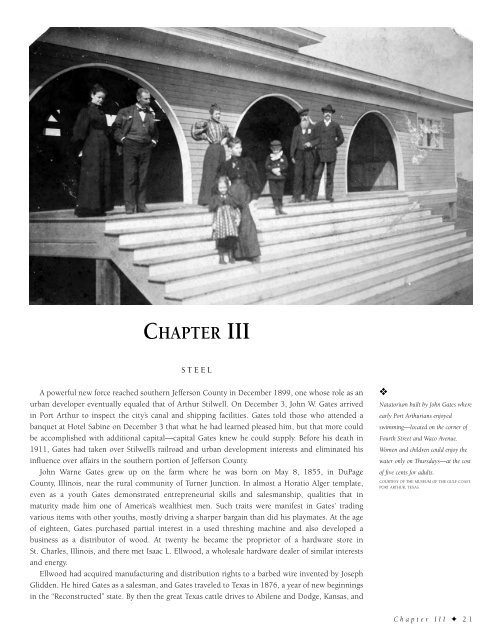Water Rails & Oil - Historic Mid & South Jefferson County
An illustrated history of the Mid and South Jefferson County area, paired with the histories of companies, families and organizations that make the region great.
An illustrated history of the Mid and South Jefferson County area, paired with the histories of companies, families and organizations that make the region great.
Create successful ePaper yourself
Turn your PDF publications into a flip-book with our unique Google optimized e-Paper software.
CHAPTER III<br />
STEEL<br />
A powerful new force reached southern <strong>Jefferson</strong> <strong>County</strong> in December 1899, one whose role as an<br />
urban developer eventually equaled that of Arthur Stilwell. On December 3, John W. Gates arrived<br />
in Port Arthur to inspect the city’s canal and shipping facilities. Gates told those who attended a<br />
banquet at Hotel Sabine on December 3 that what he had learned pleased him, but that more could<br />
be accomplished with additional capital—capital Gates knew he could supply. Before his death in<br />
1911, Gates had taken over Stilwell’s railroad and urban development interests and eliminated his<br />
influence over affairs in the southern portion of <strong>Jefferson</strong> <strong>County</strong>.<br />
John Warne Gates grew up on the farm where he was born on May 8, 1855, in DuPage<br />
<strong>County</strong>, Illinois, near the rural community of Turner Junction. In almost a Horatio Alger template,<br />
even as a youth Gates demonstrated entrepreneurial skills and salesmanship, qualities that in<br />
maturity made him one of America’s wealthiest men. Such traits were manifest in Gates’ trading<br />
various items with other youths, mostly driving a sharper bargain than did his playmates. At the age<br />
of eighteen, Gates purchased partial interest in a used threshing machine and also developed a<br />
business as a distributor of wood. At twenty he became the proprietor of a hardware store in<br />
St. Charles, Illinois, and there met Isaac L. Ellwood, a wholesale hardware dealer of similar interests<br />
and energy.<br />
Ellwood had acquired manufacturing and distribution rights to a barbed wire invented by Joseph<br />
Glidden. He hired Gates as a salesman, and Gates traveled to Texas in 1876, a year of new beginnings<br />
in the “Reconstructed” state. By then the great Texas cattle drives to Abilene and Dodge, Kansas, and<br />
❖<br />
Natatorium built by John Gates where<br />
early Port Arthurians enjoyed<br />
swimming—located on the corner of<br />
Fourth Street and Waco Avenue.<br />
Women and children could enjoy the<br />
water only on Thursdays—at the cost<br />
of five cents for adults.<br />
COURTESY OF THE MUSEUM OF THE GULF COAST,<br />
PORT ARTHUR, TEXAS.<br />
Chapter III ✦ 21
















